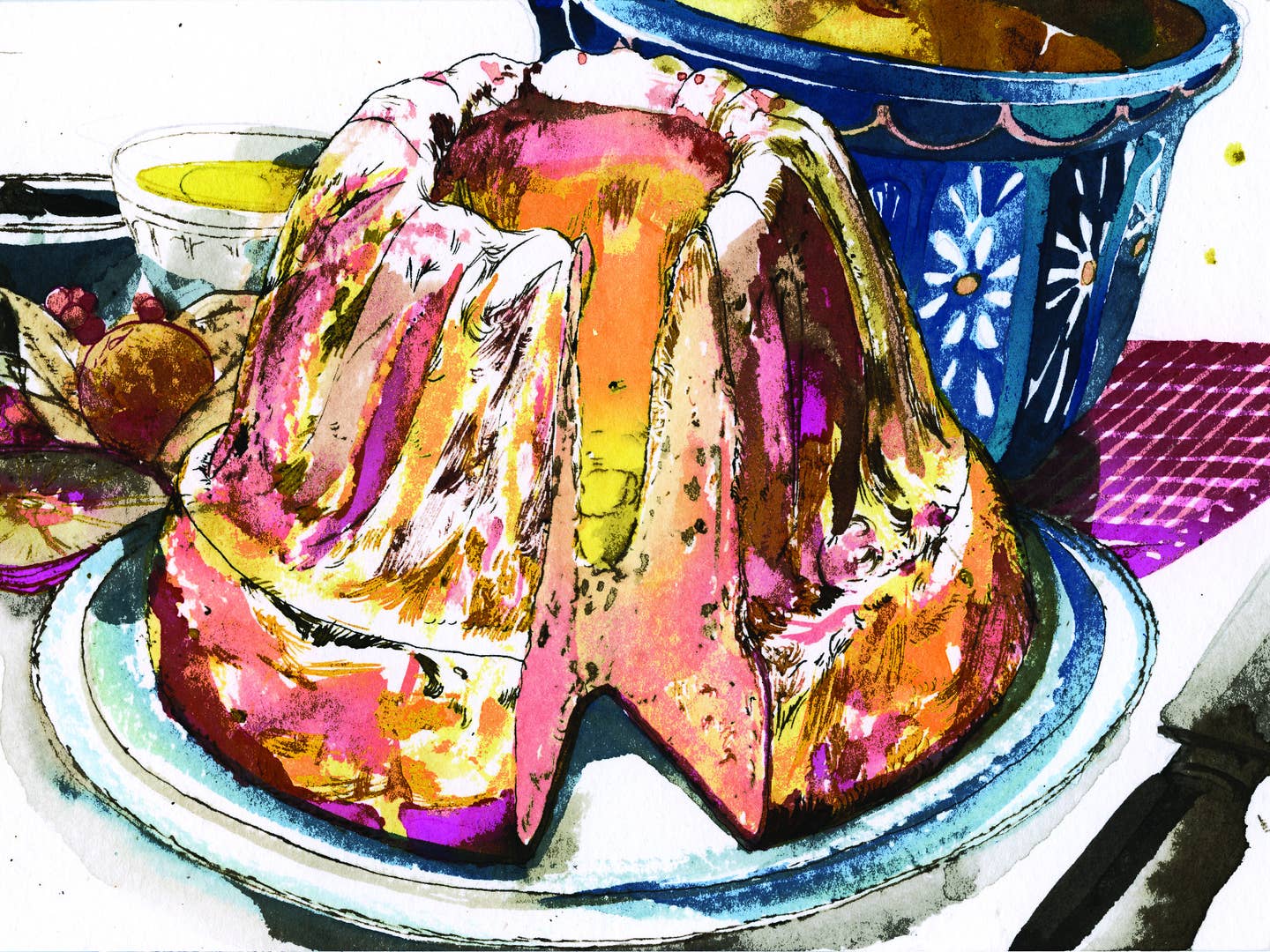
The Incredible Kugelhopf of Christine Ferber
Edward Behr gets the family recipe for a beguiling Alsatian cake
I arrived in a wet snowfall at 6 a.m., the same time as the young employees and apprentices. It was December 3 at Maison Ferber, the family's shop in the village of Niedermorschwihr, in the hills just west of the city of Colmar in Alsace. Christine Ferber, pâtissier-confiseur, had the somberness of someone who lacks sleep. She always wakes up early, she said, and works long hours. She joined her father, Maurice, in the family business in 1980. She had trained in Paris and brought back with her a sense of luxury. Maurice, dressed in crisp white, set the tone of the workshop—happy but disciplined, with a strong seriousness of purpose.
I had come to see Christine make her kugelhopf. It's a cake, but more precisely, it's a form of brioche that's baked in a mold shaped like a turban, with a whole almond set at the top of each spiral. A thorough dusting of powdered sugar picks out the twisting relief and gives a sensation of added moisture. Like the brioches of other regions, a kugelhopf is leavened with yeast and is rich with eggs and butter, but it also contains raisins, often macerated beforehand in eau-de-vie. The tender crust is brown except in the hollow center, which is as pale yellow as if it were underdone.
The texture of a good kugelhopf is somewhat bubbled and open, even a little stretched in the way of an Italian panettone. The almonds become lightly toasted. They're just the right presence to set off the rest of the taste—you wouldn't want them in every bite. The kugel is traditional for breakfast. I always think it's best late on a cool afternoon with a glass of good, sweet Alsace wine.
The kugelhopf may be Viennese in origin. It's made in a vast Germanic stretch of Europe, including Austria, Switzerland, southern Germany, and, in France, Alsace, where it's made exceptionally well. The name and spelling—kouglof, gugelhupf, gouglouf, and more—are unsettled even within Alsace. The kugel part is supposed to refer to a medieval hat, while hopf refers to yeast.
On the counter, Christine made a neat circle of flour, pouring the sugar and salt on separate parts of the arc. In the middle went milk and a piece of bread dough saved from the day before, to bring full flavor to the fermentation. She began to stir with one hand, bringing the ingredients together until they formed a very loose dough. Whenever I've tried to knead a rich wet dough by hand, I've produced a steadily expanding mess. Her dough remained uncannily neat.
Kugelhopf
Pastry chef Christine Ferber’s not-too-sweet kugelhopf, an Alsatian cake baked in a distinctive ring mold, has just a few choice raisins per slice. Enjoy with a sweet Alsatian wine, like gewürztraminer or muscat.
“You can't work by the clock,” she said. “Five minutes for this? And so much time in the oven?” Her tone was incredulous. “That depends on your oven.” Impressively, her hand kneading continued for almost an hour, by which time the dough was smooth and cohering, coming up easily from the marble.
What does it take to make a truly good kugelhopf?
"Old earthenware molds," Christine answered. The workshop held shelves of the brown molds. After years of baking, butter had entered through tiny cracks in the glaze, filling the pores of the clay and giving the kugels a faint, pleasing odor of rancidity, part of the essential kugel richness. You can buy new molds made in the pottery village of Soufflenheim, near Strasbourg, but their center opening is fatter, and the Ferbers had found they are not the same. When from time to time a mold would break, the Ferbers sought old ones as replacements.
Other factors contribute to the success of a kugelhopf. Atmospheric pressure, for instance. And practice. “You have to know how to do it,” Maurice Ferber said. “You have to learn how to succeed—that's all.”
When the kugelhopfs were done and taken from the oven, they were immediately unmolded. I watched as a worker pulled each burning-hot, heavy cake from its mold with his fingertips, and in a single motion upended the cake, while still holding on to the wide bottom, and set it on a rack. That's not easy to do—I know, I unmolded two myself without grace. A hot kugel is easy to damage, because it doesn't yet have a firm shape.
When the kugels were cool and firm enough to cut, we tasted them. Cakey, buttery, and rich, marked by the closely related flavors of butter and a full fermentation, which always make me think just a little of sweet cherries.
"You know," Christine said when her father was out of earshot, "he doesn't like to give out recipes. He doesn't like it when I give out recipes—he doesn't even like to give me recipes. On the day he told me how to make kugelhopfs, he said, 'Flour as much as necessary, yeast in sufficient amount.'" She wasn't really criticizing him. She put a hand on my shoulder for emphasis. "'Feel it first in your heart,' he said. 'You will feel the knowledge flow from your heart to your arm to your hand. The day when you know that, you will know how to make kugelhopfs.'"
Get the recipe for Kugelhopf »
Edward Behr's The Food and Wine of France, from which this essay was adapted, will be released in June.
Keep Reading
Continue to Next Story










